AN EDITOR IN TRANSITION
A Tale of Two Cities
 By MIKE PASINI
By MIKE PASINI
Editor
The Imaging Resource Digital Photography Newsletter
SAN FRANCISCO -- Grabbing a bus for the last leg home after a whirlwind trip to Las Vegas to cover the Consumer Electronics Show, we piled our baggage behind the driver and sat down in the seats for people who look as old as they feel. Across from us, a young lady was chatting with her friend, who also just happened to be driving the bus.
|
|
"You cut your hair? It looks nice," she said.
"No, girl, you know what this is? It's just all gelled down. They take a stocking cap," she explained, "with all this cutouts -- whatever you want -- and do your hair."
"Imagine that!" her friend was amazed.
"Modern technology, girl. I tell you, it can do anything," the driver summed it up.
We kept that in mind as we dumped our bags and caught a streetcar for Macworld Expo where Apple's Steve Jobs had just introduced the iPhone and Apple TV. We felt the news, like our luggage, had shifted from Las Vegas, breaking under the strain of over 140,000 conventioneers, to San Francisco, cool as ice this January.
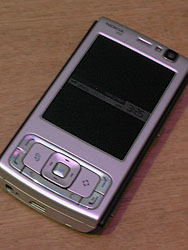
Nokia's 5-Mp Camphone. Nokia's camphone optimized for stills.
We'd spent some time chatting with Nokia's Mikko Pilkama about the companies two new phones, one optimized for stills with a 5-megapixel sensor and the other optimized for video with the largest lens we've seen on a camphone. Later we took a look at the company's Web browser. Famous for making things easy to use, Nokia had a nice interface on the N800. We saw it navigate a Web page much like you navigate a large image in Photoshop, moving a rectangle around with the arrow keys.

iPhone Front
But then we saw how you navigate a Web page with the iPhone. It's more like dancing with pixels than navigating.
What would you rather do, girl? Navigate or dance?
The sad thing is that CES was showing off Windows Vista. At last. The "Wow!" begins here, billboards all over Las Vegas said. But talking to some tech guys from a big company we won't name, we go the same old story about Windows. They were frustrated chasing changes in Vista code to restore their own product functionality. Like getting a printer to deliver a good looking photo. Every revision, something that had worked broke. So they had no confidence in Vista's stability and even less in its architecture. And they were worried about being Vista compliant on release. There just wasn't enough time to iron things out.
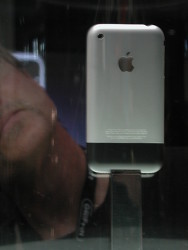
iPhone Back
On the other hand, the iPhone doesn't actually exist yet except as a prototype. A handful of journalists have played with it for a few minutes, notably the N.Y. Times David Pogue (http://bits.blogs.nytimes.com/2007/01/09/some-hands-on-time-with-the-iphone/) and PC Magazine's Cade Metz (http://www.pcmag.com/article2/01895,2082444,00.asp). As a camera, it's hard to get very excited about a 2-Mp device these days. And nothing was said about its video capability except with the lens on the back, it can't be used for iChatting. Pogue has a nice FAQ about iPhone's capabilities (http://pogue.blogs.nytimes.com/2007/01/11/the-ultimate-iphone-frequently-asked-questions/).
Hard to dance without music. You look a little foolish.
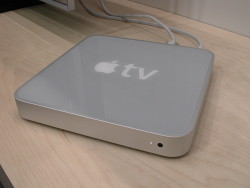
Apple TV
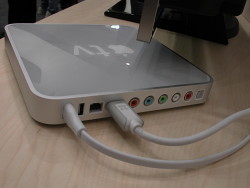
Power & HDMI cables
The interesting thing to us was that as CES was more about integrating functions within a device, especially at Nokia where the company is devoted to multimedia devices, the model moving forward at Macworld as the iPod.
The iPhone itself is based on the closed architecture of the iPod -- even to the point of the battery, which can't be replaced by the user. But the software architecture, based on a version of OS X, is also closed. Jobs explained this as a security measure, really, guaranteeing that the phone works. You don't want to load something only to find out you can't dial out.
But Apple TV is based on the same concept. After a slew of questions to one of the tech's on the floor, we asked, "So would you say this is more or less an iPod that uses an HD flat screen for output?" He thought about it a few seconds and nodded, "You know, that's a good way of putting it." I'd only add that for input, you have access to your entire network, not just one computer. But same game. The box only knows what iTunes tells it (with a small exception for Elements).
Oh, the slew of answers: maximum resolution supported is 720p, you can either sync content to its 40-GB hard drive or stream it from up to five computers, it will be available in February.
Photographers, on the other hand, tend to prefer another model entirely, perhaps derived from pet ownership, in which every camera is loved but no single camera is sufficient. You may, for example, have your favorite dSLR, which is just a delight to handle and a thrill every time you hear that shutter snap. But you also have your pocketable digicam you can take anywhere, whip out and get a snapshot or a quick video, a sort of buddy you can't leave home without.
You aren't much impressed with camphones even though you own one. You never remember to use it, in fact. You wish you would remember, but it just doesn't occupy the same space in your brain that your digicam and dSLR do.
But not all consumers are photographers, we realize.
Over and over again at CES, we kept hearing two things. Consumers want ease of use and consumers will, with their pocketbooks, show manufacturers what combination of features they want in a product.
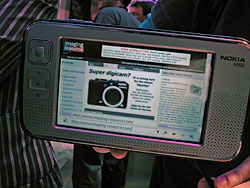
Nokia N800. A Web browser (displaying the Imaging Resource home page) and Internet phone.
Ease of use would seem to be a no brainer. But almost no one knows how to do it. Manufacturers have to tell you their products are easy to use. And they all do. But are they? Instead of a "Wow!" you end up scratching your head, trying to understand what's so great about it. Nokia's Web browser is just one example (and that's a fairly friendly system with an obvious use). An even better example is Kodak's Golden Eye technology.
With Golden Eye --which Kodak's Nancy Carr alluded to in the panel discussion we covered (http://www.imaging-resource.com/EVENTS/CES07mrp/ces-glimpse.htm) -- a computer outfitted with a Bluetooth dongle watches for a Bluetooth device coming within range. When one does, they automatically pair. As you use your camphone or digicam in range of the computer, images are automatically sent to your Gallery account when you snap the shutter. You almost don't need to store them in the camera any more. And, theoretically anyway, they are also tagged so they're easier to manage later. Automatically, in the case of GPS data, say.
No "Wow!" from you?
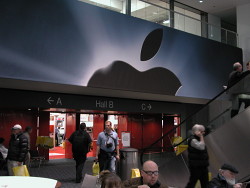
Apple Banner. It's Apple Inc. now, not Apple Computer Inc.
But watch Jobs scroll an iTunes list on the iPhone by flicking his finger and there's that "Wow!" And that gotta-have-it feeling. If it does scrolling that well, it must do everything well. And how cool is that? (And here comes the backlash against Cingular -- uh, AT&T -- and the missing features like voice dialing and hard to use keyboard and ....)
Apple has taken a different approach to these two big ideas. They've spent years refining their understanding of ease of use and human interface design. And they don't wait for consumers to tell them what they want. They define what's cool and create demand. That's why people with four iPods gotta have a fifth the minute they see it. It's cooler than the other four.
We haven't spent the last two days gelling our hair for bright ideas about these different worlds. We've actually been out on the floor at Macworld Expo talking to people and discovering quite a few things of interest to photographers. Canon, Epson, HP, Nikon, O'Reilly, Visible Dust and some hard drive manufacturers were all in attendance with useful products. As soon as we unpack, we'll recap them for you in our next piece. So stay tuned!